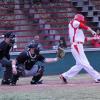- 0
Odd Call
Umpire-Empire locks topics which have not been active in the last year. The thread you are viewing hasn't been active in 2751 days so you will not be able to post. We do recommend you starting a new topic to find out what's new in the world of umpiring.
-
Similar Content
-
- 1 answer
- 1,134 views
-
- 24 replies
- 3,435 views
-
- 25 replies
- 3,714 views
-
- 104 replies
- 7,528 views
-
- 9 replies
- 2,601 views
-



Question
isired
Bases loaded, no out. Batter hits a roller to the pitcher, who throws to F6 covering 2B - bang-bang play, F6 on 2B, R1 slides into bag, R1 called out. Field ump then calls interference in R1, I guess for a hard slide, though directly at the base. F6 never made the throw.
Umpire calls it a double play, AND puts R2 and R3 back to 2B and 3B, no runs scored.
Forget about the initial call, that's judgement, but can they call the BR out AND send the runners back with no runs scored? Never seen that before. Major League rules.
Link to comment
Share on other sites
Top Posters For This Question
30
9
6
4
Popular Days
Oct 31
19
Sep 25
16
Sep 26
13
Nov 1
11
Top Posters For This Question
isired 30 posts
Richvee 9 posts
Replacematt 6 posts
Magic 4 posts
Popular Days
Oct 31 2016
19 posts
Sep 25 2016
16 posts
Sep 26 2016
13 posts
Nov 1 2016
11 posts
Popular Posts
Replacematt
Just stop. You had a lot of respect here until you pulled this bullSH*# out. The kid, and that is what he is, made a mistake. It happens. I have yet to see an umpire, at any level, even approach the a
grayhawk
I don't think anyone takes exception to comments about a call being missed. It happens to ALL of us. It's taking it to the next level where the motivations and thought process of the umpire are bein
ALStripes17
28-30 IS young in the umpire world. And the way your last few posts read, youre the reason the young umpires aren't able to be retained. As Rich said before, you had a lot of respect from this forum u
68 answers to this question
Recommended Posts